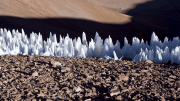- More by Caleb Simmons
The Moon is shrinking, moving further away and shaking itself apart
| Al-Sahawat Times |
To be notified of developments as they break |
|---|
Al-Sahawat Times | Ethical Global News from Oman and UAE | Donate HERE
It has slimmed down by about 50m (150 feet) during the last several hundred million years, according to the US space agency.
According to NASA, the moon gets “wrinkles” – just as a grape wrinkles when it shrinks down to a raisin.
However, the moon’s surface crust is not flexible like a raisin, but brittle, it said.
This means when the moon shrinks it creates “thrust faults” – where one area of the crust pushes up over another neighbouring part of the surface.
Seisometers were placed on the lunar surface by astronauts during the Apollo 11, 12, 14, 15 and 16 missions to measure the strength of the quakes.
A total of 28 moonquakes were recorded between 1969 and 1977 – measuring 2 to 5 on the Richter scale.
The moment magnitude scale measures a quake in terms of the amount of energy that is released and is now the most commonly used worldwide to log large events.
Researchers examining the seismic data gathered during NASA’s Apollo missions traced the location of some of the quakes to step-shaped cliffs called scarps on the lunar surface.
They formed relatively recently, in geological terms, due to the ongoing subtle shrinking of the moon as its hot interior cools.
New analysis of the data found that six of the quakes happened when the moon was at its farthest point from the Earth in its orbit.
Thomas Watters, lead author of the study, said: “Our analysis gives the first evidence that these faults are still active and likely producing moonquakes today as the moon continues to gradually cool and shrink.
NASA said detailed images taken of the surface by its lunar reconnaissance orbiter (LRO) spacecraft showed landslides and boulder tracks – further evidence that these faults are active.
John Keller, of NASA’s Goddard Space Flight Centre, said: “It’s really remarkable to see how data from nearly 50 years ago and from the LRO mission has been combined to advance our understanding of the moon while suggesting where future missions intent on studying the moon’s interior processes should go.”
NASA announced earlier this year that it wants to send the first woman, and the next man, to the moon by 2024.
Renee Weber, a planetary seismologist at NASA’s Marshall Space Flight Centre, said establishing a new network of seismometers on the lunar surface “should be a priority for human exploration of the moon, both to learn more about the moon’s interior and to determine how much of a hazard moonquakes present”.
The study was published in the journal, Nature Geoscience.
Since you’re here …
… we have a small favour to ask. More people are reading Al-Sahawat Times than ever but advertising revenues across the global media industry are falling fast. And unlike many news organisations, we haven’t put up a total paywall. We want to keep our journalism as open as we can. So you can see why we need to ask for your help. Al-Sahawat Times’ independent, investigative journalism takes a lot of time, money and hard work to produce. But we do it because we believe truly ethical media and an unbias perspective really matters.
“I appreciate there not being a paywall: it is more democratic for the media to be available for all and not a commodity to be purchased by a few. I’m happy to make a contribution so others with less means still have access to information.”
If everyone who reads our reporting, who likes it, helps fund it, the future of ethical media and the futures of our staff and their families would be much more secure. For as little as £1, you can support Al-Sahawat Times and it only takes a minute. Thank you.
This story is available on:
APPLE NEWS | GOOGLE NEWS | AL-SAHAWAT TIMES
Talk to a journalist
Email: NewsDesk@alsahawat.com
Web: alsahawat.com
Follow Al-Sahawat Times
⬆️ Follow on Instagram
⬆️ Follow on Twitter
⬆️ Follow on LinkedIn
⬆️ Follow on Facebook
⬆️ Follow on YouTube
?Read it on FLIPBOARD






